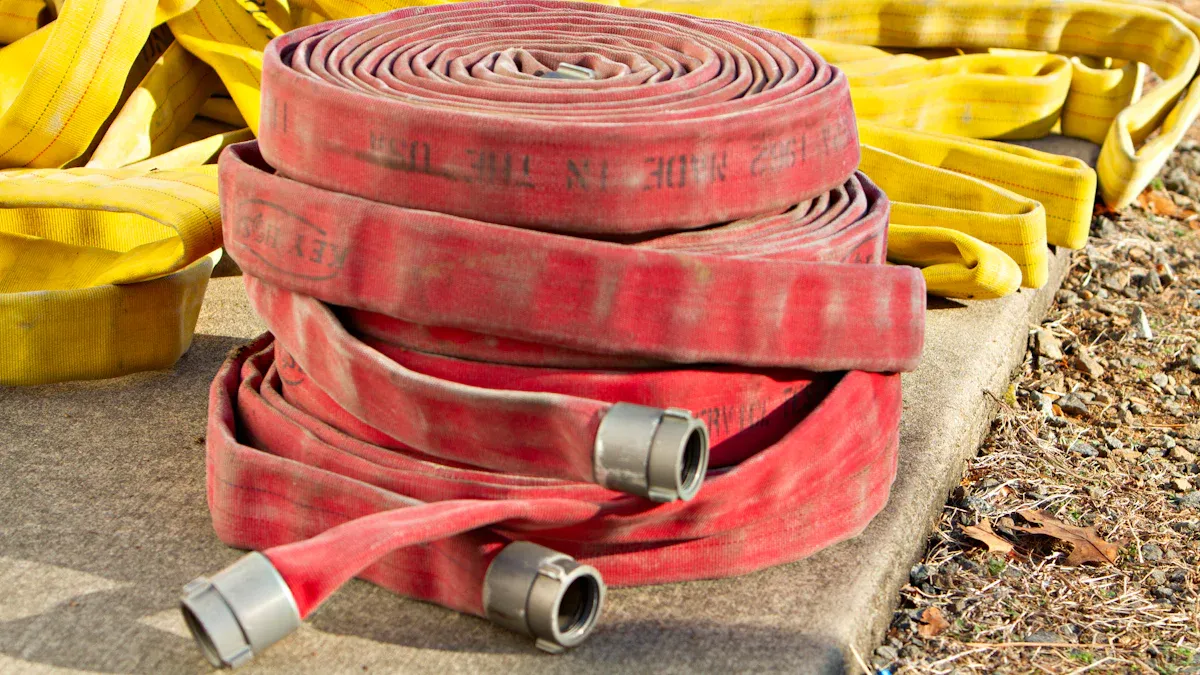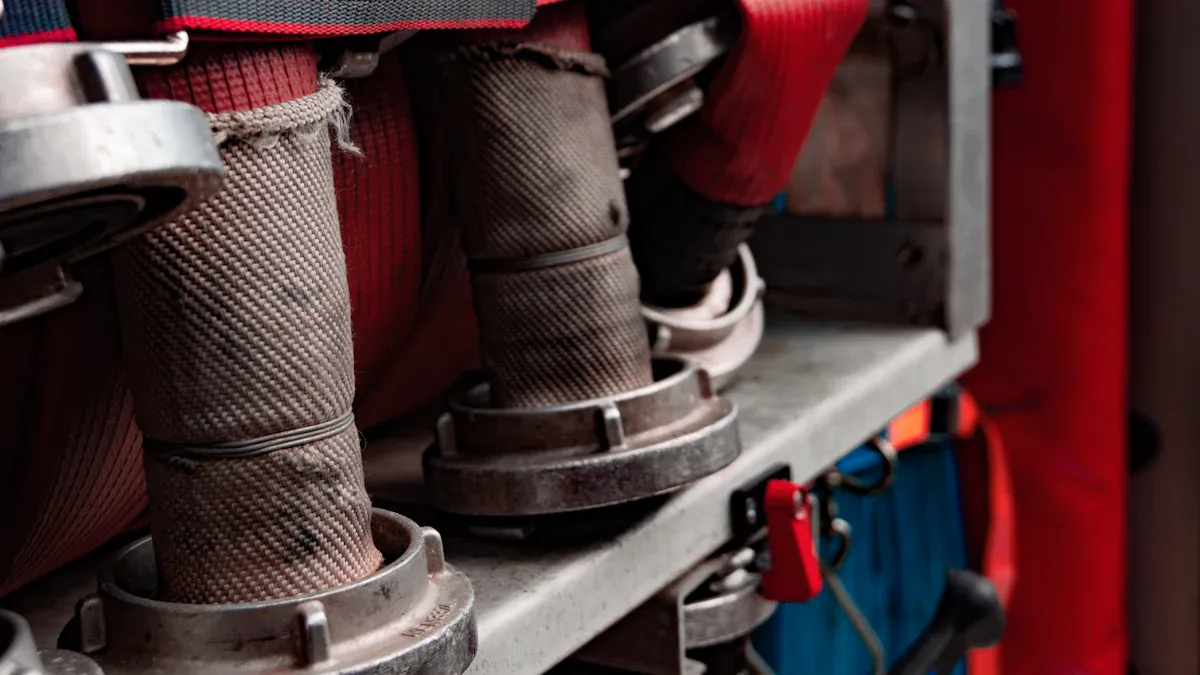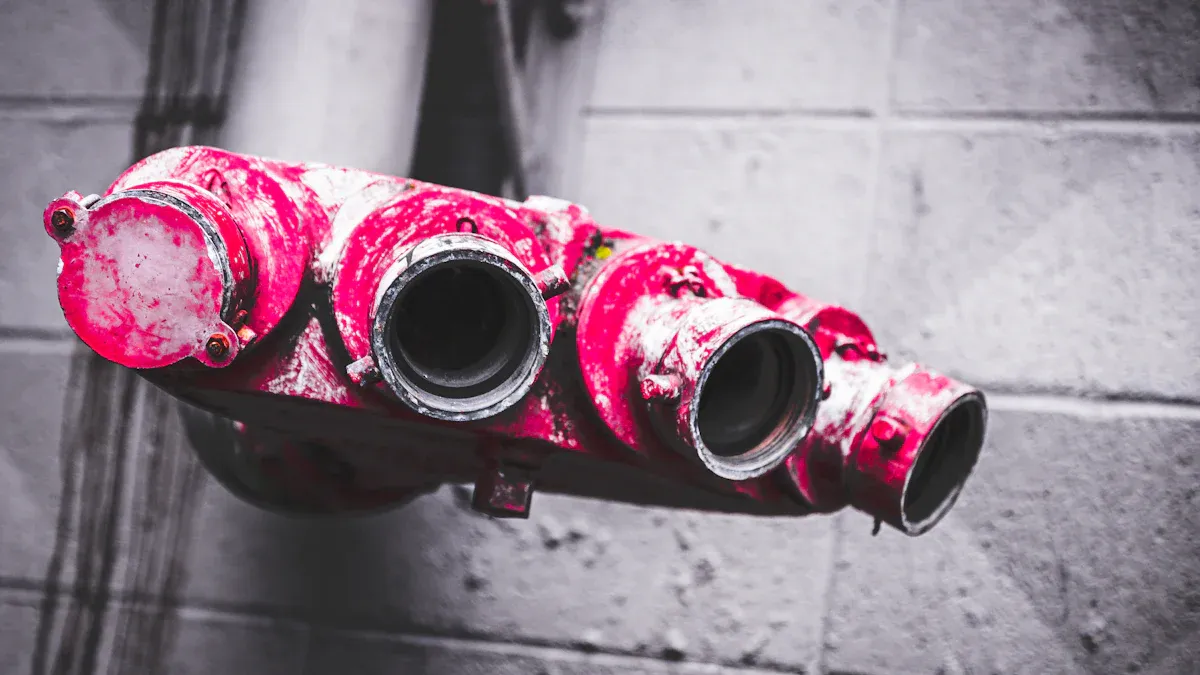
Fire hose coupling standards play a crucial role in ensuring compatibility across firefighting systems worldwide. Standardized couplings enhance firefighting efficiency by allowing seamless connections between hoses and equipment. They also improve safety during emergencies and foster international collaboration. Manufacturers like Yuyao World Fire Fighting Equipment Factory contribute to this effort by producing reliable fire hose reel systems, hose reel cabinets, and fire hose reel&cabinet solutions that align with global standards.
Key Takeaways
- Fire hose coupling rules make sure hoses fit together worldwide. This helps keep people safe and speeds up work during emergencies.
- Knowing the differences in hose types and threads in different areas is important for firefighting in other countries.
- Using common rules like NFPA 1963 and buying adapters can help fire teams fix fitting problems and act faster.
Understanding Fire Hose Coupling Standards
What Are Fire Hose Coupling Standards?
Fire hose coupling standards define the specifications for connecting hoses to firefighting equipment. These standards ensure compatibility between different systems, enabling firefighters to work efficiently during emergencies. They cover aspects such as thread types, dimensions, and materials, which vary across regions. For example, the BS336 Instantaneous coupling is widely used in the UK and Ireland, while the Bogdan Coupler is common in Russia.
| Coupling Type | Characteristics | Standards/Usage |
|---|---|---|
| BS336 Instantaneous | Similar to camlock fittings, available in 1+1⁄2-inch and 2+1⁄2-inch sizes. | Used by UK, Irish, New Zealand, Indian, and Hong Kong fire brigades. |
| Bogdan Coupler | Sexless coupling, available in sizes DN 25 to DN 150. | Defined by GOST R 53279-2009, used in Russia. |
| Guillemin Coupling | Symmetrical, quarter-turn closing, available in various materials. | Standard EN14420-8/NF E 29-572, used in France and Belgium. |
| National Hose Thread | Common in the US, features male and female straight threads with gasket sealing. | Known as National Standard Thread (NST). |
These standards play a vital role in ensuring that fire hoses can be deployed quickly and securely, regardless of the region or equipment used.
The Role of Standards in Firefighting Safety and Efficiency
Fire hose coupling standards enhance safety and operational efficiency during firefighting. They prevent leaks and ensure durable connections, reducing the risk of equipment failure in critical situations. ISO 7241, for instance, guarantees compatibility and durability, facilitating rapid deployment of fire hoses.
| Aspect | Description |
|---|---|
| Standard | ISO 7241 |
| Role | Ensures compatibility and durability of fire hose couplings |
| Benefits | Facilitates fast deployment and prevents leaks during firefighting operations |
By adhering to these standards, manufacturers like Yuyao World Fire Fighting Equipment Factory contribute to global firefighting efforts. Their products align with international requirements, ensuring reliability and compatibility across diverse systems.
Types of Fire Hose Couplings

Threaded Couplings and Their Regional Variations
Threaded couplings are among the most widely used types in firefighting systems. These couplings rely on male and female threads to create a secure connection between hoses and equipment. However, regional variations in thread standards can pose challenges for compatibility. For instance, the National Pipe Thread (NPT) is commonly used in general applications, with sizes ranging from 4 to 6 inches. The National Standard Thread (NST), another popular option, is typically 2.5 inches in size. In New York and New Jersey, unique standards like the New York Corporate Thread (NYC) and the New York Fire Department Thread (NYFD/FDNY) are prevalent.
| Region/Standard | Coupling Type | Size |
|---|---|---|
| General | National Pipe Thread (NPT) | 4″ or 6″ |
| General | National Standard Thread (NST) | 2.5″ |
| New York/New Jersey | New York Corporate Thread (NYC) | Varies |
| New York City | New York Fire Department Thread (NYFD/FDNY) | 3″ |
These variations highlight the importance of understanding regional standards when selecting fire hose couplings for international operations.
Storz Couplings: A Global Standard
Storz couplings have gained widespread acceptance as a global standard due to their unique design and versatility. Unlike threaded couplings, Storz couplings feature a symmetrical, non-shut-off design that allows for quick and flexible attachment in either direction. This capability proves invaluable during emergencies, where every second counts.
- Key Advantages of Storz Couplings:
- Quick connection capability facilitates rapid deployment of fire hoses.
- Compatibility across various sizes enhances their adaptability.
- Resistance to environmental factors ensures reliability in diverse conditions.
- Forged aluminum construction reduces the risk of breakage.
- Storz couplings can be connected in either direction, simplifying their use in high-pressure situations.
- Their ease of assembly and disassembly makes them a preferred choice for firefighters worldwide.
These features make Storz couplings an essential component in modern firefighting systems.
Other Common Coupling Types in Firefighting
In addition to threaded and Storz couplings, several other types are widely used in firefighting. Guillemin couplings, for example, are popular in France and Belgium. These symmetrical couplings use a quarter-turn mechanism for secure connections. Another example is the BS336 Instantaneous coupling, which is prevalent in the UK and Ireland. Its camlock-style design ensures quick and reliable attachment.
Each coupling type serves specific regional or operational needs, emphasizing the importance of selecting the right coupling for the job. Manufacturers like Yuyao World Fire Fighting Equipment Factory play a crucial role in producing high-quality couplings that meet these diverse requirements, ensuring compatibility and reliability across global firefighting systems.
Challenges in Global Compatibility for Fire Hose Couplings
Regional Differences in Standards and Specifications
Fire hose coupling standards vary significantly across regions, creating challenges for global compatibility. Countries often develop their own specifications based on local firefighting needs, infrastructure, and historical practices. For example, the BS336 Instantaneous coupling is widely used in the UK, while the National Standard Thread (NST) dominates in the United States. These regional preferences make it difficult for fire departments to collaborate internationally or share equipment during emergencies.
Note: Regional differences in standards can hinder cross-border firefighting efforts, especially during large-scale disasters requiring international aid.
Manufacturers must navigate these variations to produce couplings that meet diverse requirements. Some companies, such as Yuyao World Fire Fighting Equipment Factory, address this issue by offering products compatible with multiple standards. Their approach ensures that fire hoses can be deployed effectively in various regions, promoting global firefighting efficiency.
Variations in Thread Types and Dimensions
Thread types and dimensions represent another major obstacle to global compatibility. Fire hose couplings rely on precise threading to create secure connections, but these threads differ widely across regions. For instance:
- National Pipe Thread (NPT): Common in general applications, featuring tapered threads for sealing.
- National Standard Thread (NST): Used in firefighting, with straight threads and gasket sealing.
- New York Fire Department Thread (NYFD): Unique to New York City, requiring specialized adapters.
| Thread Type | Characteristics | Common Usage Regions |
|---|---|---|
| NPT | Tapered threads for tight sealing | General applications worldwide |
| NST | Straight threads with gasket sealing | United States |
| NYFD | Specialized threads for NYC firefighting | New York City |
These variations complicate equipment interoperability. Fire departments often rely on adapters to bridge the gap between incompatible threads, but this adds time and complexity during emergencies. Manufacturers must prioritize precision engineering to ensure their products meet diverse threading requirements.
Material and Durability Standards Across Regions
Material and durability standards for fire hose couplings differ based on environmental conditions and operational demands. In regions with extreme temperatures or high humidity, couplings must withstand harsh conditions without compromising performance. For example:
- Europe: Couplings often use forged aluminum for lightweight durability.
- Asia: Stainless steel is preferred for its corrosion resistance in humid climates.
- North America: Brass couplings are common due to their strength and reliability.
| Region | Preferred Material | Key Benefits |
|---|---|---|
| Europe | Forged Aluminum | Lightweight and durable |
| Asia | Stainless Steel | Corrosion-resistant |
| North America | Brass | Strong and reliable |
These material preferences reflect regional priorities but complicate global standardization. Manufacturers like Yuyao World Fire Fighting Equipment Factory address this challenge by using high-quality materials that meet international durability standards. Their products ensure reliable performance across diverse environments, supporting global firefighting efforts.
Solutions to Achieve Global Compatibility
Adoption of Universal Standards Like NFPA 1963
Universal standards, such as NFPA 1963, play a pivotal role in achieving global compatibility for fire hose couplings. These standards establish uniform specifications for threads, dimensions, and materials, ensuring seamless interoperability between firefighting systems worldwide. By adhering to these guidelines, manufacturers can produce couplings that meet international requirements, reducing the risk of incompatibility during emergencies.
NFPA 1963, for instance, provides detailed specifications for fire hose connections, including thread types and gasket designs. This standard ensures that couplings from different regions can connect securely, facilitating efficient firefighting operations. Manufacturers like Yuyao World Fire Fighting Equipment Factory align their products with such universal standards, contributing to global firefighting efforts.
Use of Adapters and Conversion Tools
Adapters and conversion tools offer practical solutions to compatibility challenges in firefighting systems. These devices bridge the gap between couplings with different thread types or dimensions, enabling firefighters to connect hoses and equipment seamlessly.
The Oakland Hills Fire incident in 1991 underscores the importance of adapters. Firefighters encountered hydrants with 3-inch connections instead of the standard 2 1/2-inch size. This mismatch delayed their response, allowing the fire to spread rapidly. Proper adapters could have mitigated this issue, highlighting their critical role in firefighting.
- Key Benefits of Adapters and Conversion Tools:
- Enable compatibility between diverse coupling types.
- Reduce response times during emergencies.
- Enhance operational flexibility for fire departments.
By investing in high-quality adapters, fire departments can overcome regional differences in standards and ensure readiness for any situation.
Promoting International Collaboration Among Manufacturers
Collaboration among manufacturers is essential for advancing global compatibility in fire hose systems. By sharing knowledge and resources, companies can develop innovative solutions that address regional variations in standards. Joint efforts also foster the adoption of universal guidelines, such as NFPA 1963, across the industry.
Manufacturers like Yuyao World Fire Fighting Equipment Factory exemplify this approach. Their commitment to producing couplings that meet diverse international standards demonstrates the potential of collaborative efforts. Partnerships between manufacturers, regulatory bodies, and fire departments can further enhance compatibility, ensuring that firefighting systems remain effective in any region.
Tip: Fire departments should prioritize working with manufacturers that actively participate in international standardization initiatives. This ensures access to reliable and compatible equipment.
Case Study: Storz Couplings in Fire Hose Systems

Design Features of Storz Couplings
Storz couplings are renowned for their robust design and operational efficiency. Their symmetrical, sexless construction allows for quick and secure connections without the need to align male and female ends. This feature significantly reduces response times during emergencies. Engineers have analyzed the isothermal model of Storz couplings to evaluate their performance under various conditions.
| Aspect | Details |
|---|---|
| Model | Isothermal model of Storz coupling used in fire hose coupling |
| Diameter | Nominal diameter of 65 mm (NEN 3374) |
| Load Interval | From F=2 kN (actual water pressure) to extreme conditions with F=6 kN |
| Material | Aluminum alloy EN AW6082 (AlSi1MgMn), treatment T6 |
| Analysis Focus | Stress and strain distributions, maximum von Mises stress |
| Application | Performance improvements in firefighting, especially marine systems |
The use of high-strength aluminum alloy ensures durability while maintaining a lightweight structure. These features make Storz couplings a reliable choice for modern firefighting operations.
Global Adoption and Compatibility Benefits
The global adoption of Storz couplings highlights their compatibility benefits. Firefighters worldwide value their quick-connect design, which enables hose connections in as little as five seconds. Traditional systems often take over 30 seconds, making Storz couplings a game-changer in time-sensitive scenarios.
- Key Benefits of Global Adoption:
- Faster response times during emergencies.
- Simplified training for firefighters due to universal design.
- Enhanced interoperability between international firefighting teams.
Their widespread use in Europe, Asia, and North America demonstrates their versatility and effectiveness in diverse environments.
Lessons for Standardization from Storz Couplings
The success of Storz couplings offers valuable lessons for standardization in firefighting equipment. Their universal design eliminates the need for adapters, reducing complexity during emergencies. Manufacturers can draw inspiration from this approach to develop other standardized components.
Storz couplings also emphasize the importance of material quality and durability. By adhering to strict specifications, they ensure consistent performance across various conditions. This commitment to quality serves as a benchmark for future innovations in fire hose systems.
Practical Tips for Fire Departments on Fire Hose Compatibility
Selecting the Right Fire Hose Couplings
Choosing the appropriate fire hose couplings is critical for ensuring operational efficiency and safety. Fire departments should evaluate the compatibility of couplings with their existing equipment and regional standards. For instance, departments operating in the United States may prioritize National Standard Thread (NST) couplings, while those in Europe might prefer Storz couplings for their universal design. Additionally, the material of the coupling plays a significant role. Aluminum is lightweight and durable, making it ideal for rapid deployment, while brass offers superior strength for high-pressure applications. Departments should also consider the size and thread type to ensure seamless connections during emergencies.
Regular Maintenance and Inspection Practices
Routine maintenance and inspections are essential for maintaining the reliability of fire hose couplings. Fire departments should implement a structured inspection process to identify potential issues before they escalate.
| Inspection Criteria | Description |
|---|---|
| Unobstructed | Ensure the hose valve is not blocked by any objects. |
| Caps and Gaskets | Verify that all caps and gaskets are properly in place. |
| Connection Damage | Check for any damage to the connection. |
| Valve Handle | Inspect the valve handle for any signs of damage. |
| Leakage | Ensure that the valve does not leak. |
| Pressure Device | Confirm that the pressure-restricting device is in place. |
Departments should also pressurize hoses to their rated levels, maintain the pressure for a set duration, and observe for leaks or bulges. Documenting these tests ensures accountability and helps track the condition of equipment over time.
Training Firefighters on Coupling Usage and Compatibility
Proper training equips firefighters with the skills needed to handle various coupling types effectively. Departments should conduct regular workshops to familiarize personnel with the operation of different couplings, such as threaded and Storz designs. Training should also emphasize the importance of inspecting couplings for damage and ensuring compatibility with other equipment. Simulated emergency scenarios can help firefighters practice connecting hoses under pressure, improving their response times during real incidents. By investing in comprehensive training, fire departments can enhance their readiness and ensure the effective use of fire hose systems.
Fire hose coupling standards play a vital role in ensuring global compatibility. They enhance safety, improve operational efficiency, and enable seamless international collaboration. Standardization simplifies equipment interoperability, reducing delays during emergencies. Manufacturers like Yuyao World Fire Fighting Equipment Factory contribute significantly by producing high-quality, globally compatible solutions that meet diverse regional requirements.
FAQ
What are the most common fire hose coupling standards worldwide?
The most common standards include BS336 (UK), NST (US), and Storz (global). Each standard ensures compatibility and safety for firefighting operations in its respective region.
How can fire departments ensure compatibility with international firefighting teams?
Fire departments can use adapters, follow universal standards like NFPA 1963, and train personnel on coupling variations to ensure seamless collaboration during international emergencies.
Tip: Partnering with manufacturers like Yuyao World Fire Fighting Equipment Factory ensures access to globally compatible equipment.
Why are Storz couplings considered a global standard?
Storz couplings feature a symmetrical design, enabling quick connections without alignment. Their durability and ease of use make them ideal for diverse firefighting scenarios worldwide.
Post time: May-24-2025

